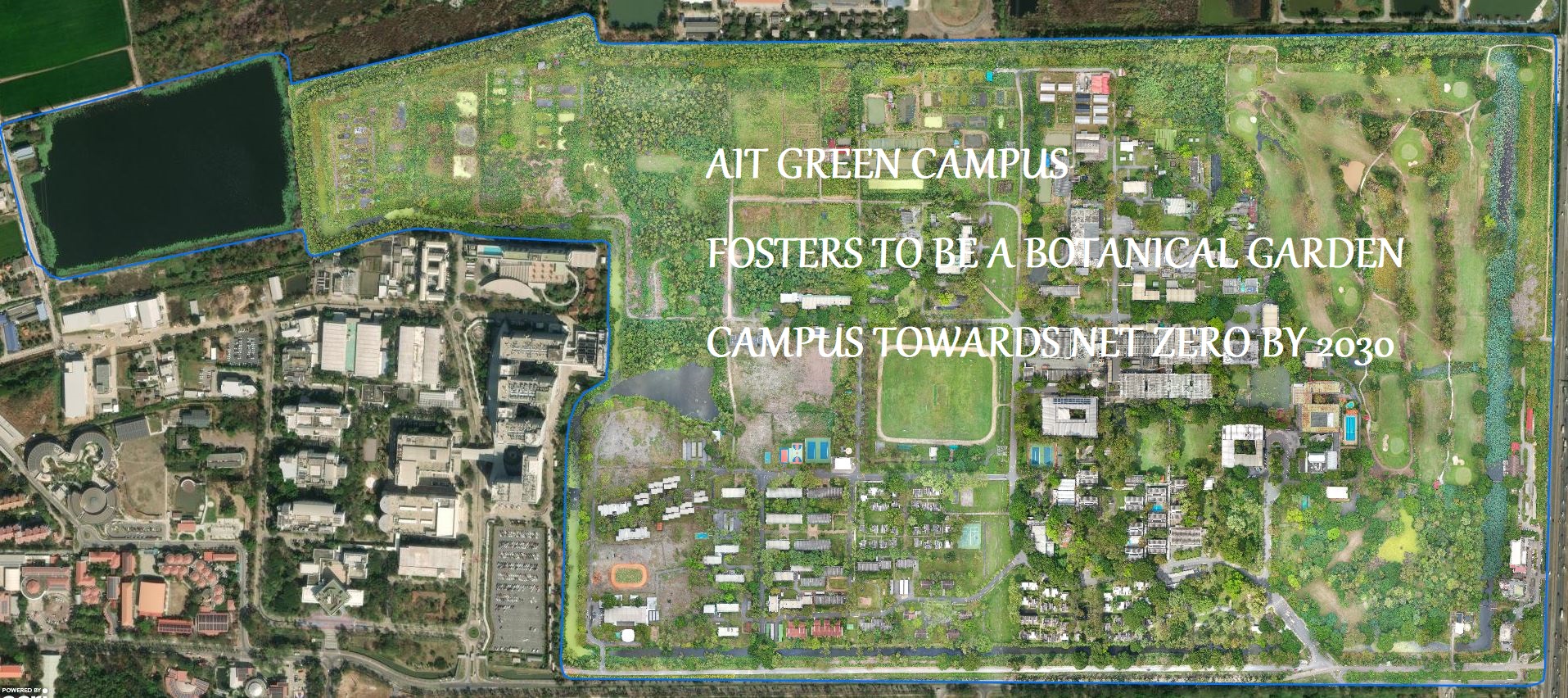
With reference to AA-1-2-9 AIT Sustainability Policy published on 8 December 2021, Annex-5 states that
AIT is committed to maintaining 70% of current forest cover with multiple tree species and improving the waterways to provide a green living environment and habitats for fish and wildlife species.
AIT is committed to creating “no touch” (set aside) areas on the campus, areas that are left natural and are not touched by maintenance staff. Those areas will become habitats for various species and the area that needs to be maintained (e.g. grass cutting) will be reduced, as well as the associated carbon dioxide emissions to enhance carbon sequestration.
AIT acknowledges its role as a custodian of a substantial and ecologically significant area. In recognition of the institute’s commitment to environmental stewardship, academic research, and its dedication to the well-being of its multicultural community, this policy seeks to reduce the impact of invasive species on campus. This will preserve the ecological balance that supports the campus’s flora and fauna and will continue to provide a green haven for its students and staff from over 45 countries.
With the following Nature and Ecosystems Goals:
1. To manage individual trees to maintain a 90% healthy natural ecosystem by 2030
2. To undertake the enrichment planting of the native trees, especially the IUCN red-list trees to replace a maximum of 10% of unhealthy and dangerous trees on campus per year
3. To restore 90% of the forest ecosystem along the waterways by 2030 to protect soil erosion and improve water quality.
4. To conserve 90% of the appropriate space as habitats for fishes and different wildlife species
5. To create an AIT Biodiversity map to monitor all species on the campus (Could be done by the Sustainability/Biodiversity Club)
6. To stop conversion of natural ecosystems to other uses by practicing proper campus land use planning
General Guidelines to promote conservation of nature and healthy ecosystem
- Encourage the integration of sustainable practices into university initiatives, focusing on the preservation, revival, and responsible utilization of terrestrial ecosystems, encompassing forests, grasslands, mountains, wetlands, soil, and wildlife.
- Ensure the upkeep of a healthy ecosystem through regular assessments and the removal of diseased trees. Emphasize the use of organic fertilizers and landscape compost for plant maintenance, while completely phasing out the use of chemical fertilizers.
- Advocate for reforestation efforts and the safeguarding of biodiversity. This includes the strategic planting of new trees to replace hazardous or deteriorating ones, with careful consideration given to species selection to maximize benefits for both human and wildlife.
- Establish a goal to heighten greenhouse gas absorption from trees, aligning with the commitment to achieve a Net Zero Campus by 2030.
- Support the preservation of biodiversity, especially for rare and endangered species of plants and animals listed on the IUCN Red List, emphasizing the need for their protection.
- Formulate preemptive measures or guidelines to prevent any detrimental impacts on the conservation and sustainable use of natural resources.
Guidelines on Alien Species Impact Reduction
- Prevention: Initiatives will be undertaken to prevent the introduction of invasive species, consistent with AIT’s dedication to climate change, smart communities, and sustainable resource management research themes.
- Conduct educational outreach about invasive species within AIT’s international community.
- Institute biosecurity measures to prevent the establishment of invasive species.
- Early Detection and Rapid Response (EDRR): A proactive approach will be employed to swiftly identify and manage new incursions of invasive species, leveraging AIT’s research strengths in technology and policy development.
- Engage the academic departments in early detection through innovative research and community science.
- Implement a reporting system that enables the diverse campus community to easily share observations of potential invasive species.
- Control and Eradication: AIT will use environmentally responsible methods for controlling and eradicating invasive species, informed by its expertise in food-energy-water nexus and infrastructure technologies.
- Restore areas with native vegetation suitable for the local climate and AIT’s diverse ecosystems.
- Apply best practices in integrated pest management, combining physical, biological, and, when necessary, chemical controls with a strong preference for organic and sustainable methods.
- Research and Monitoring: Continuous research and monitoring will be vital to adaptively manage invasive species, reflecting AIT’s thematic focus on infrastructure, technology, and society.
- Monitor the effectiveness of management strategies, incorporating research findings from AIT’s academic community.
- Document biodiversity changes and ecosystem service benefits as invasive species are managed.
- Community Engagement: Community engagement will be central to AIT’s strategy, fostering a collaborative environment for students, faculty, and staff from diverse backgrounds.
- Organize community-led habitat restoration projects that also serve as educational experiences.
- Leverage the diverse perspectives within AIT’s community to enhance understanding and innovative solutions to invasive species management.